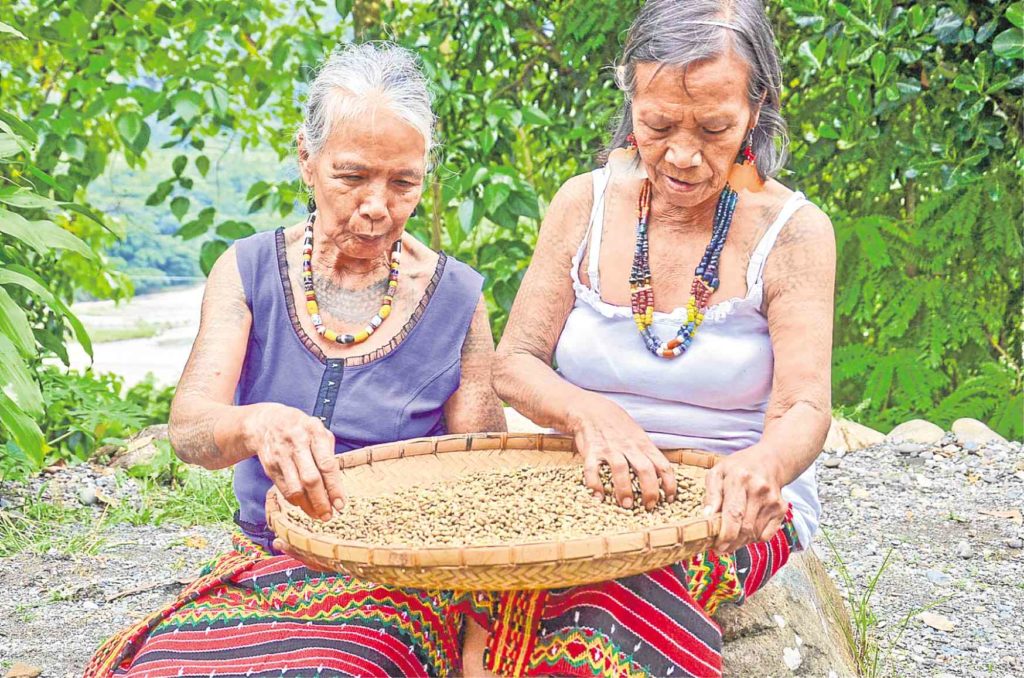
The sorting of dried coffee beans is mainly done by women in the coffee growing communities of the Cordillera.
BAGUIO CITY—For the past decade, farmers have struggled to supply at least a tenth of the country’s demand for coffee, the world’s second most traded commodity.
In 2017, the country produced 28.5 million kilograms of coffee. However, the output represented just 6.8 percent of the 417 million kg of coffee consumed in the same year, said Myrna Pablo, national coordinator of the government’s coffee industry cluster, citing a December 2017 report of the foreign agricultural service of the US Department of Agriculture.
“There has been a steady increase in the number of coffee consumers for more than a decade but the production trend has remained flat,” she said during the Philippine Coffee Conference, held for the third time here on March 21 and 22.
Top consumer
This thirst for coffee has made the country the fifth top consumer in the world, according to the same report. This has also made the country the world’s top importer of soluble or instant coffee (360 million kg), and the fourth biggest coffee importer (soluble and green coffee beans).
The Philippines imports mainly from Vietnam and Indonesia.
Trade Secretary Ramon Lopez said that with local coffee consumption continuing to grow, the government has been implementing measures to revitalize the sector.
In 2012, policymakers and stakeholders started drafting the Philippine Coffee Industry Roadmap, which was approved in March 2017.
As planned, the country should be fully sufficient by 2021.
Lopez said the top producing regions were all in Mindanao. Soccsksargen (Region 12) in south central Mindanao is the top producer, followed by Davao (Region 11), the Autonomous Region in Muslim Mindanao, and northern Mindanao (Region 10).
All four coffee varieties—Arabica, Excelsa, Liberica and Robusta—are grown in the country.
“The local government units reported progress since the roadmap was rolled out last year. It may be slow but we are gaining good momentum,” Pablo said.
In Cordillera, output has not been growing fast due to aging trees and the shift to cash crops like corn, according to Danilo Daguio, regional technical director of the Department of Agriculture (DA).
Coffee trees yield fewer beans as they age.
This is the reason many farmers abandon or cut them down without replanting as it takes years before a tree bears fruit.
For instance, the Arabica variety, prized for its rich aroma, takes at least six years to reach full productivity.
Lopez said the lack of production can also be addressed by changing the mindset of farmers.
Leo Balagot (above), who is in charge of the nursery, checks the readiness for plotting of germinated Red Bourbon Arabica coffee at the Bureau of Plant Industry facility in Baguio.
Not just producers
According to him, farmers need to look “not just as producers but to think entrepreneurial by mastering concepts such as packaging, right market and timing as well as improving their financial literacy.”
In her keynote address, Sen. Cynthia Villar, chair of the Senate committees on agriculture and food, said increasing farm output alone “cannot move farmers permanently from poverty.”
Farmers need to learn to develop agribusinesses by converting farms into tourism destinations with restaurants and homestay facilities, or as agriculture training centers, she said.
Coffee growers can also do inter-cropping to maximize yield, especially for small farms which do not exclusively grow coffee, said Agriculture Undersecretary Evelyn Laviña, who handles the DA’s high value crops unit.
Coffee intercropping
She said coffee intercropping with coconut and the provision of high quality seedlings would improve production.
The DA allotted P154.59 million this year for coffee programs.
Villar said the coconut industry development fund, which was approved by the Senate on March 19, can also be used for intercropping of coffee and coconut.
For non-coconut growing areas like the Cordillera, coffee has been intercropped with pine trees and other forest trees, according to Oliver Oliem, Luzon representative of the Philippine Coffee Council.
Coffee farmers are now willing to adapt to new technologies and strategies after knowing the effects of climate change, said Ruth Novales, Philippine Coffee Council co-chair and vice president for corporate affairs of Nestlé Philippines.
But the government needs to improve its efforts to effectively support the one-value chain from planting seedlings to consumption, she said.
“We do not need a lot of programs … it can be just few effective programs which can be replicated from Luzon to Mindanao,” she said.